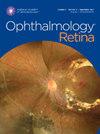Stellate Nonhereditary Idiopathic Foveomacular Retinoschisis and Central Anomalous Retinoschisis with mid-PEripheral Traction
IF 5.7
Q1 OPHTHALMOLOGY
引用次数: 0
Abstract
Purpose
To report the clinical and multimodal imaging (MMI) findings and long-term follow-up of stellate nonhereditary idiopathic foveomacular retinoschisis (SNIFR) contiguous with midperipheral retinoschisis (MPRS) and to describe a severe SNIFR variant termed CARPET (Central Anomalous Retinoschisis with mid-PEripheral Traction).
Design
Retrospective case series.
Subjects
Eleven patients (15 eyes) with SNIFR contiguous with MPRS in at least 1 eye at baseline or final follow-up.
Methods
Multimodal imaging features, including cross-sectional and en face macular and peripheral spectral-domain OCT and OCT angiography, were reviewed in all cases at baseline and at the final follow-up visit.
Main Outcome Measures
Various courses (including progression, regression, or stability) of MPRS or SNIFR over time were evaluated.
Results
Midperipheral retinoschisis exhibited centripetal progression to SNIFR in 5 eyes of 3 patients with follow-up of 67, 60, and 27 months, respectively, with maintenance of excellent visual acuity (range: 20/25–20/20) in 4 of these 5 eyes. In 2 eyes of 2 patients (including 1 eye with initial centripetal progression of MPRS to SNIFR), MPRS contiguous with SNIFR spontaneously resolved with long-term follow-up (77 and 25 months, respectively). Stellate nonhereditary idiopathic foveomacular retinoschisis contiguous with MPRS partially regressed after 48 months in 1 patient, and was stable after 54 months in another. A distinctive midperipheral microvasculopathy, associated with MPRS that was contiguous with SNIFR, was identified in 7 eyes of 4 patients. Finally, 3 eyes of 3 patients exhibited additional unique features, including central neurosensory detachment and outer lamellar macular hole, which were associated with significant midperipheral traction, representing a severe variant subtype of SNIFR that we refer to as CARPET. Two of these 3 eyes progressed with short-term follow-up of 6 and 2 months, respectively, whereas the schisis resolved and vision improved after pars plana vitrectomy in the third case.
Conclusions
Midperipheral retinoschisis can progress to SNIFR over multiple years of follow-up. Stellate nonhereditary idiopathic foveomacular retinoschisis with MPRS can also spontaneously resolve or remain stable. Midperipheral retinoschisis can additionally be complicated by a midperipheral inner retinal microvasculopathy. Finally, CARPET may represent a unique and severe variant form of SNIFR driven by midperipheral vitreoretinal traction and associated with significant vision loss.
Financial Disclosure(s)
Proprietary or commercial disclosure may be found in the Footnotes and Disclosures at the end of this article.
全文标题:星状非遗传性特发性中央黄斑视网膜裂和中央异常视网膜裂伴中外周牵引(CARPET)。
目的:报告星状非遗传性特发性中央黄斑视网膜裂(SNIFR)合并中周视网膜裂(MPRS)的临床和多模态成像(MMI)结果和长期随访,并描述一种称为CARPET(中枢性异常视网膜裂伴中周牵引)的严重SNIFR变体。设计:回顾性病例系列。受试者:11例(15只眼睛)在基线或最终随访时至少有一只眼睛伴有SNIFR和MPRS。方法:在基线和最后随访时回顾所有病例的MMI特征,包括横断面和面黄斑和周围光谱域光学相干断层扫描(OCT)和OCT血管造影。主要结局指标:评估MPRS或SNIFR随时间的不同病程(包括进展、消退或稳定性)。结果:3例患者5眼MPRS向心性进展为SNIFR,随访时间分别为67、60和27个月,其中4眼视力维持良好(范围:20/25-20/20)。在2例患者的2只眼中(包括1只最初由MPRS向心性进展为SNIFR的眼),MPRS伴SNIFR在长期随访中(分别为77个月和48个月)自行消退。1例合并MPRS的SNIFR在48个月后部分消退,另1例在54个月后稳定。在4例患者的7只眼睛中发现了一种独特的中外周微血管病变,与与SNIFR相邻的MPRS相关。最后,3例患者的3只眼睛表现出额外的独特特征,包括中枢神经感觉脱离和外板层黄斑孔,这些特征与明显的中外周牵拉相关,代表了SNIFR的严重变体亚型,我们称之为CARPET。其中2例分别在6个月和2个月的短期随访中出现进展,而第三例在玻璃体切割后分裂消失,视力改善。结论:经过多年的随访,MPRS可以发展为SNIFR。具有MPRS的SNIFR也可以自发溶解或保持稳定。此外,MPRS可并发中外周视网膜内微血管病变。最后,CARPET可能是一种独特而严重的SNIFR变体,由中外周玻璃体视网膜牵引驱动,并伴有明显的视力丧失。
本文章由计算机程序翻译,如有差异,请以英文原文为准。
求助全文
约1分钟内获得全文
求助全文

 求助内容:
求助内容: 应助结果提醒方式:
应助结果提醒方式:


